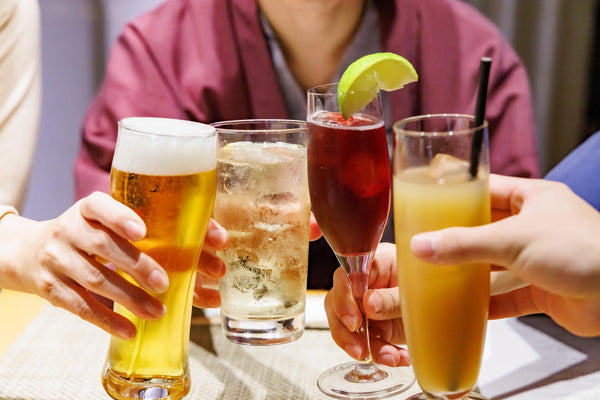
Jump to:
When you first walk into a café in Japan, you may be inclined to stick to what you know and order familiar beverages, such as coffee, Coke, or orange juice. While there is, of course, a comprehensive lineup of such beverages available, you are missing out if you don’t try some of the unique drinks that Japan has to offer.
From alcoholic drinks, such as traditional sake and shochu, to unique soft drinks, such as Calpis and Ramune, and distinctive teas, such as matcha and mugicha, there is a diverse range of beverage options to suit every palate. This article will provide a general guide to all of the Japanese drinks you definitely need to try in Japan. Later on in the post, we will look at some alcoholic options, but we will start by looking at some soft drinks and teas.
“Must Try” Non-Alcoholic Drinks
Japanese Canned Coffee

While coffee itself may be nothing new, you may be surprised, on first arriving in Japan, to see it served up conveniently in a can. In fact, the “canned coffee" phenomenon in Japan is a fascinating aspect of the country's beverage culture that often intrigues foreigners.
Available in an extensive variety of flavors and styles, from rich black coffee to sweetened milk coffee, these ready-to-drink cans are conveniently sold in vending machines and convenience stores across Japan, offering a quick caffeine fix at any time of the day or night.
Ramune Soda

Derived from the English word “lemonade”, Ramune soda bears a closer resemblance to lemonade as enjoyed in the UK, closer to Sprite or 7-Up than the non-carbonated lemonade popular in the U.S. This drink, which comes in a vast range of flavors in addition to lemon, is known by many Japanese children (and “children at heart”) as the taste of summer festivals, where hordes of kids can be seen slugging this ice-cold soda served in returnable glass bottles sealed with a marble. Flavors include more familiar fruits, such as strawberry and melon, as well as Japanese varieties, such as Yuzu. If you are feeling adventurous, there are some weird and (possibly) wonderful Ramune options including Takoyaki (baked octopus) flavor. If you would like to purchase more conventional Ramune online, you can do so here (and if you need help opening the bottle, check out this article.)
Japanese Soda

Japanese sodas offer a delightful array of unique and refreshing flavors. Popular choices include Melon Fanta and Peach Fanta, both bursting with fruity goodness. The intriguing Peach Pepsi puts a fun twist on the classic cola. For anime fans, the limited-edition Japanese sodas such as Sailor Moon soda adds a touch of magic to your drink. The exotic lychee sparkling water provides a subtle, refreshing taste, while Strawberry Coke combines the beloved cola with a sweet berry twist. Traditional strawberry Ramune brings nostalgia and a fizzy, fruity delight in every sip.
Pocari Sweat

Don’t be put off by the name! It highlights that this drink is designed to replenish the electrolytes lost through sweat, rather than describing its contents. Developed by Otsuka Pharmaceutical, this popular sports drink is marketed in some countries simply as “Pocari.” Unlike many Western sports drinks, Pocari Sweat has a mild, slightly sweet, and somewhat salty flavor, making it easier on the stomach and palatable even during intense workouts. Its composition is carefully balanced to mimic the body's natural fluids, ensuring efficient hydration when taken during or after exercise, or even after over-indulgence on alcohol. Pocari Sweat has been a pioneer in the sports drink market, leading to a range of similar products. You can purchase it in online in powdered form or as a jelly.
Mitsuya Cider

Mitsuya Cider is another Japanese drink with a name that can be confusing to foreigners, as cider is an alcoholic drink in the West. Created in 1984, the taste might best be described as a cross between ginger ale and Sprite. In recent years, the brand has expanded to include various flavors (such as Mitsuya Lemon Cider), as well as limited edition releases. Its popularity has also gone beyond drinks to a number of spinoff products, including these fruit candies.
Amazake

Despite its name, which literally means "sweet alcohol" in Japanese, amazake—a traditional drink made by mixing rice, rice koji, and water—often contains little to no alcohol. When it does contain alcohol, the levels are very low. Although it is commonly served hot at New Year's and other winter festivals, amazake was traditionally a summer drink used to combat the effects of natsu-bate (summer fatigue). This is due to its rich source of vitamin B, nine essential amino acids, friendly intestinal bacteria, and digestive enzymes. Enjoying a hot cup of amazake after the first shrine visit of the year (Hatsumode) on a cold winter's day is definitely a "must try" experience. If you can’t wait until New Year, however, you can pick up some online here. You can also get more information about Amazake and other healthy Japanese drinks in this article.
Japanese Tea

Japan has a huge range of unique teas for you to try. In addition to the “green teas” (defined by level of oxidation and not by its color), there are teas made from special ingredients, and also unique twists on Western teas.
Green Tea (Ryokucha)

Green tea, which can be defined as tea where the leaves are steamed to prevent oxidation, comes in various types, each with distinct characteristics and processing methods. Sencha is the most common, in which the steaming process preserves the green color and fresh flavor of the tea. Gyokuro is a premium type of green tea, where the sweetness and umami are enhanced by growing it in the shade. Matcha is finely ground green tea powder, used in traditional tea ceremonies, as well as for a culinary ingredient. Bancha makes use of the larger, coarser leaves harvested later in the season, and thus has less sweet and grassy, and a milder, toastier flavor. Hojicha is a roasted green tea with a stronger toasty, nutty taste and very low in caffeine. Genmaicha blends green tea with roasted brown rice, creating a nutty, slightly sweet flavor, and like Hojicha is low in caffeine, making it a popular evening tea. Kukicha includes stems and twigs, and offers a light, slightly sweet taste. Each type provides a unique taste experience, reflecting Japan's rich tea culture.
Japanese “Teas” Made from Non-Tea Ingredients (Mugi Cha & Soba Cha)

There are several “teas” in Japan, that are not made from tea at all. One of the most common of these is Mugicha. Rather than being made with tea, this is made with roasted barley grains, and is a popular caffeine-free beverage, particularly enjoyed cold in the summer. If you want a mineral boost from your tea, you might like to try Kombucha, made with powdered kelp, which is also enjoyed for its rich Umami flavor. Sobacha, made from buckwheat, has a nutty flavor, is caffeine-free, and brings a number of health benefits, including being equipped with two powerful antioxidants, rutin and quercetin.
Royal Milk Tea

Royal Milk Tea is a unique twist on English tea that blends strong black tea, such as Assam or Darjeeling, with a generous amount of milk and sugar. This popular drink can be enjoyed both hot and cold, and in addition to being served in cafes, can be found pre-packaged in convenience stores and vending machines. Another popular milk-based drink in Japan would be milo chocolate milk.
Yakult

Yakult is a popular probiotic drink known for its health benefits. But what is Yakult exactly? It's a fermented milk beverage containing the beneficial bacteria Lactobacillus casei Shirota. These probiotics support digestive health by promoting a balanced gut microbiome. The benefits of Yakult include improved digestion, enhanced immune function, and reduced symptoms of lactose intolerance. So, is Yakult good for you? Yes, incorporating Yakult into your daily routine can contribute to overall well-being. Enjoying a Yakult drink regularly can be a simple and tasty way to support your digestive and immune health.
“Must Try” Japanese Alcoholic Drinks
Japan boasts a rich tradition of unique alcoholic beverages that are a “Must Try” for any enthusiast.
Hoppy

Hoppy originated in Tokyo in 1948 and has become a unique and iconic Japanese beverage. Created as a low alcohol alternative to beer during the early Showa period (1926-1989) due to war and other factors, Hoppy is a beer-flavored drink with very little alcohol that is typically mixed with Shochu, a Japanese distilled spirit, to produce a light, beer-like experience. Hoppy tends to be served in a tall glass with ice, and the customer tends to pour the Shochu (called “Naka” meaning inside) and the Hoppy (called “Soto” meaning outside) themselves so they can adjust it to the desired strength. Hoppy remains a firm favorite and has experienced a retro revival in recent years.
Nihonshu

Nihonshu, commonly known as sake, is a traditional rice wine is brewed through a meticulous fermentation process involving polished rice, water, yeast, and koji mold. The brewing process can take months, and the degree of rice polishing (Seimeibuai) greatly influences the flavor profile. Nihonshu is ranked based on this Seimeibuai, and only sake for which the rice has been polished down to at least half their size can attain the highest rank of Daiginjo. Sake is not just a drink but a cultural experience, often used in ceremonial settings and paired with various Japanese dishes to enhance their flavors.
Shochu

Whereas Nihonshu is often considered Japan's national beverage, Shochu actually surpasses it in domestic consumption. Shochu is a versatile distilled liquor made from various base ingredients such as sweet potatoes, barley, buckwheat, and rice. Unlike sake, which is brewed, Shochu undergoes a distillation process, resulting in an alcohol content typically between 25-30%. Shochu can be enjoyed in multiple ways: straight, diluted with hot or cold water, on the rocks, or as part of a Chuhai (Shochu mixed with flavored carbonated water).
Japanese Whiskey

Japanese whiskey, initially inspired by Scotch, has developed its own distinctive characteristics through innovative blending techniques and the use of various cask types, including American oak, sherry casks, and Mizunara oak. These methods impart unique flavors to the whiskey. Additionally, the precise craftsmanship and varied Japanese climate, with its hot summers and cold winters, accelerate the aging process, contributing to distinct maturation differences. Major Japanese whiskey brands like Suntory, Nikka, and Kirin, along with boutique distilleries such as Chichibu, Eigashima, and Mars Whiskey, offer a diverse range of flavors from fruity and floral to smoky and peaty, distinguishing Japanese whiskey in the global market. Check out this article for more information.
Japanese Beer

While it shares fundamental ingredients and brewing practices with other beers worldwide, Japanese beer often includes rice as an ingredient, giving it a lighter, crisper taste. Additionally, some Japanese beers incorporate unique ingredients like yuzu, Sansho pepper, matcha green tea, and cherry blossom leaves. Japanese beer typically features more foam than beers from other countries, which is valued for enhancing taste and appearance. For more information on Japanese beer, see this article.
Awamori

Here, we will take a brief look at some other uniquely Japanese alcoholic drinks. Awamori, an Okinawan specialty, is made from long-grain Indica rice and black koji mold, aged in clay pots for a rich, robust flavor. Stronger than shochu, it is enjoyed in small sips for its complex profile. Umeshu, or plum wine, is a sweet, fruity liqueur made by steeping unripe plums in shochu and sugar, popular as an aperitif or dessert wine, often served over ice or in cocktails. Lemon sour, a tangy cocktail of shochu, lemon juice, and soda water, is perfect for warm evenings and is commonly found in Japanese bars and beer gardens. Yuzu wine infuses sake or white wine with the Yuzu fruit, offering a sweet-tart balance ideal for pairing with light appetizers and desserts.
Umeshu

Umeshu, or plum wine, is a sweet, fruity liqueur made by steeping unripe plums in shochu and sugar, popular as an aperitif or dessert wine, often served over ice or in cocktails.
Yuzushu

Yuzushu or Yuzu wine infuses sake or white wine with the Yuzu fruit, offering a sweet-tart balance ideal for pairing with light appetizers and desserts.
Lemon Sour & Other "Sour" Drinks

Lemon sour, a tangy cocktail of shochu, lemon juice, and soda water, is perfect for warm evenings and is commonly found in Japanese bars and beer gardens. Whereas lemon is perhaps the most common, there are various other flavors of “sour” drinks, including the citrusy flavors of grapefruit, lime, and Yuzu, and other fruit flavors such as melon, strawberry, plum, peach, and apple. There is even a type of “sour“ drink flavored with Shiso, which is a herb, and Calpis flavor, which is a milky or yogurt-like flavor with a slight citrusy tang.
“Must Try” Japanese Beverages To Quench Every Curiosity And Taste
Japan offers an incredible array of beverages that cater to every curiosity and taste, making it a haven for adventurous drink enthusiasts. Whether you are into sipping hot coffee from a can on a cold winter’s morning or 40% proof Awamori from a bottle in a bar at night, Japanese beverages offer something for everyone, and reward those who take time to explore its abundance of choices.
Non-alcoholic offerings include fermented drinks like Amazake, carbonated drinks and sports drinks, and more types of tea than you can shake a stick at.
When it comes to alcohol, Japan has unique types of alcohol, such as Nihonshu, Shochu, and Umeshu, as well as Japanese interpretations of popular Western offerings, including beer and whiskey.
Have you been blown away by something tasty you’ve drunk in Japan? Let us know in the comments.


0 comments